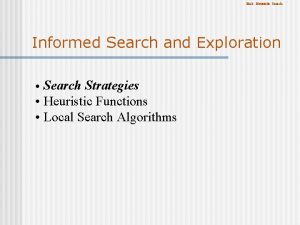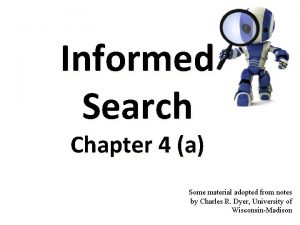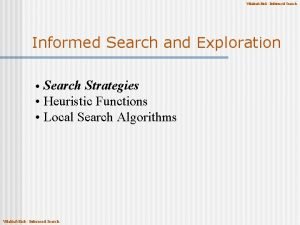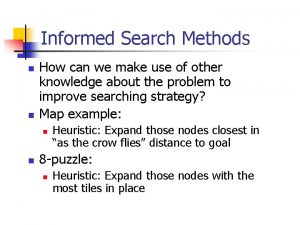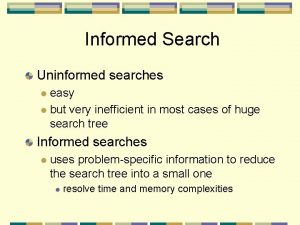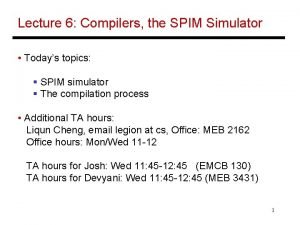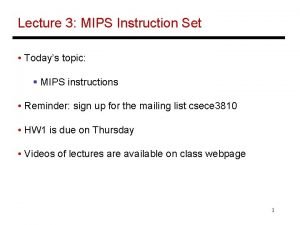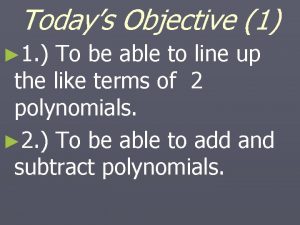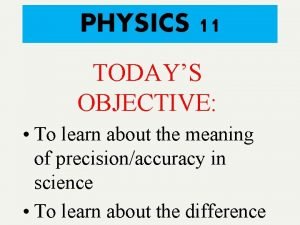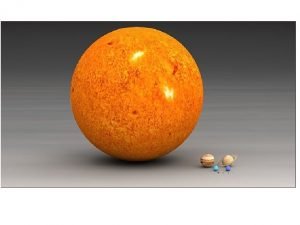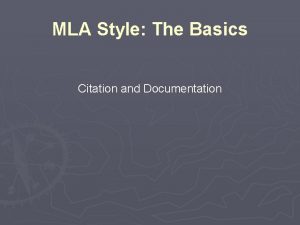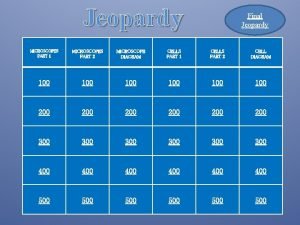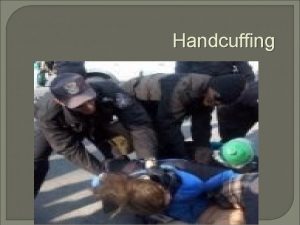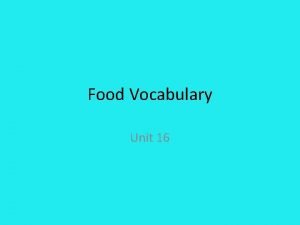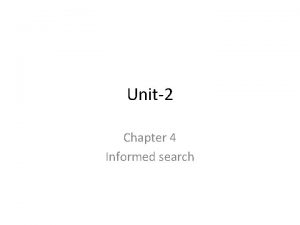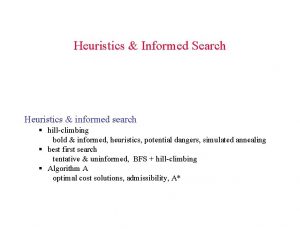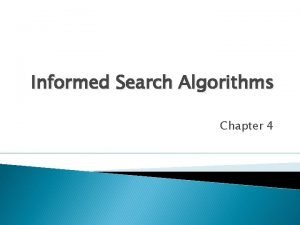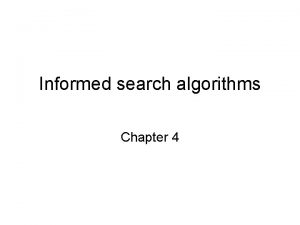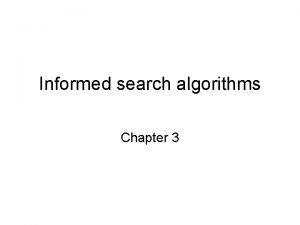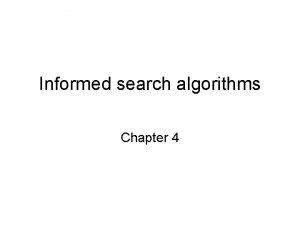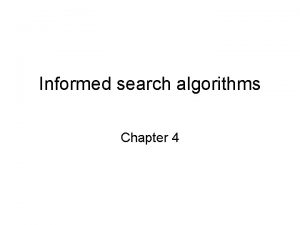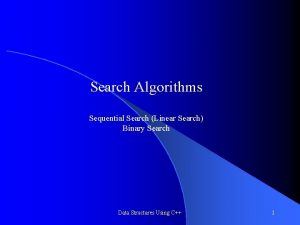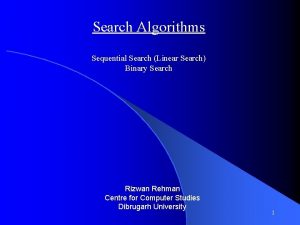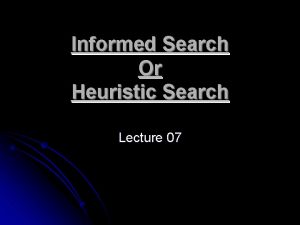Informed Search II Outline for todays lecture Informed









































- Slides: 41

Informed Search II

Outline for today’s lecture Informed Search · Optimal informed search: A* (AIMA 3. 5. 2) · Creating good heuristic functions · Hill Climbing CIS 521 - Intro to AI - Fall 2017 2

Review: Greedy best-first search: · f(n): estimated total cost of path through n to goal · g(n): the cost to get to n, UCS: f(n)= g(n) · h(n): heuristic function that estimates the remaining distance from n to goal · Greedy best-first search Idea: f(n) = h(n) • Expand the node that is estimated by h(n) to be closest to goal · Here, h(n) = h. SLD(n) = straight-line distance from ` to Bucharest CIS 521 - Intro to AI - Fall 2017 3

Review: Properties of greedy best-first search · Complete? No – can get stuck in loops, • e. g. , Iasi Neamt … · Time? O(bm) – worst case (like Depth First Search) • But a good heuristic can give dramatic improvement of average cost · Space? O(bm) – priority queue, so worst case: keeps all (unexpanded) nodes in memory · Optimal? No CIS 521 - Intro to AI - Fall 2017 4

Review: Optimal informed search: A* · Best-known informed search method · Key Idea: avoid expanding paths that are already expensive, but expand most promising first. · Simple idea: f(n)=g(n) + h(n) · Implementation: Same as before • Frontier queue as priority queue by increasing f(n) CIS 521 - Intro to AI - Fall 2017 5

Review: Admissible heuristics · A heuristic h(n) is admissible if it never overestimates the cost to reach the goal; i. e. it is optimistic • Formally: n, n a node: 1. h(n) h*(n) where h*(n) is the true cost from n 2. h(n) 0 so h(G)=0 for any goal G. · Example: h. SLD(n) never overestimates the actual road distance Theorem: If h(n) is admissible, A* using Tree Search is optimal CIS 521 - Intro to AI - Fall 2017 6

A* search example Frontier queue: Arad 366 CIS 521 - Intro to AI - Fall 2017 7

A* search example Frontier queue: Sibiu 393 Timisoara 447 Zerind 449 We add the three nodes we found to the Frontier queue. We sort them according to the CIS 521 - Intro to AI - Fall 2017 g()+h() calculation. 8

A* search example Frontier queue: Rimricu Vicea 413 Fagaras 415 Timisoara 447 Zerind 449 Arad 646 Oradea 671 When we expand Sibiu, we run into Arad again. Note that we’ve already expanded this node once; but we still add it to the Frontier queue again. CIS 521 - Intro to AI - Fall 2017 9

A* search example Frontier queue: Fagaras 415 Pitesti 417 Timisoara 447 Zerind 449 Craiova 526 Sibiu 553 Arad 646 Oradea 671 We expand Rimricu Vicea. CIS 521 - Intro to AI - Fall 2017 10

A* search example Frontier queue: Pitesti 417 Timisoara 447 Zerind 449 Bucharest 450 Craiova 526 Sibiu 553 Sibiu 591 Arad 646 Oradea 671 When we expand Fagaras, we find Bucharest, but we’re not done. The algorithm doesn’t end until we “expand” the goal node – it has to be at the top of the Frontier queue. CIS 521 - Intro to AI - Fall 2017 11

A* search example Frontier queue: Bucharest 418 Timisoara 447 Zerind 449 Bucharest 450 Craiova 526 Sibiu 553 Sibiu 591 Rimricu Vicea 607 Craiova 615 Arad 646 Oradea 671 Note that we just found a better value for Bucharest! Now we expand this better value for Bucharest since it’s at the top of the queue. We’re done and we know the value found is optimal! CIS 521 - Intro to AI - Fall 2017 12

Optimality of A* (intuitive) · Lemma: A* expands nodes on frontier in order of increasing f value · Gradually adds "f-contours" of nodes · · Contour i has all nodes with f=fi, where fi < fi+1 (After all, A* is just a variant of uniform-cost search…. ) CIS 521 - Intro to AI - Fall 2017 13

Optimality of A* using Tree-Search (proof idea ) · Lemma: A* expands nodes on frontier in order of increasing f value · Suppose some suboptimal goal G 2 (i. e a goal on a suboptimal path) has been generated and is in the frontier along with an optimal goal G. Must prove: f(G 2) > f(G) (Why? Because if f(G 2) > f(n), then G 2 will never get to the front of the priority queue. ) Proof: 1. g(G 2) > g(G) 2. f(G 2) = g(G 2) 3. f(G) = g(G) 4. f(G 2) > f(G) since G 2 is suboptimal since f(G 2)=g(G 2)+h(G 2) & h(G 2) = 0, since G 2 is a goal similarly from 1, 2, 3 Also must show that G is added to the frontier before G 2 is expanded – see AIMA for argument in the case of Graph Search CIS 521 - Intro to AI - Fall 2017 14

A* search, evaluation · Completeness: YES • • · Since bands of increasing f are added As long as b is finite — (guaranteeing that there aren’t infinitely many nodes n with f (n) < f(G) ) Time complexity: Same as UCS worst case • Number of nodes expanded is still exponential in the length of the solution. · Space complexity: Same as UCS worst case • It keeps all generated nodes in memory so exponential • Hence space is the major problem not time · Optimality: YES • Cannot expand fi+1 until fi is finished. • A* expands all nodes with f(n)< f(G) • A* expands one node with f(n)=f(G) • A* expands no nodes with f(n)>f(G) CIS 521 - Intro to AI - Fall 2017 15

Consistency · A heuristic is consistent if Cost of getting from n to n’ by any action a · Consistency enforces that h(n) is optimistic Theorem: if h(n) is consistent, A* using Graph-Search is optimal See book for details CIS 521 - Intro to AI - Fall 2017 16

Outline for today’s lecture Informed Search · Optimal informed search: A* · Creating good heuristic functions (AIMA 3. 6) · Hill Climbing CIS 521 - Intro to AI - Fall 2017 17

Heuristic functions · For the 8 -puzzle • Avg. solution cost is about 22 steps —(branching factor ≤ 3) • Exhaustive search to depth 22: 3. 1 x 1010 states • A good heuristic function can reduce the search process CIS 521 - Intro to AI - Fall 2017 18

Example Admissible heuristics For the 8 -puzzle: · hoop(n) = number of out of place tiles · hmd(n) = total Manhattan distance (i. e. , # of moves from desired location of each tile) · hoop(S) = 8 · hmd(S) = 3+1+2+2+2+3+3+2 = 18 CIS 521 - Intro to AI - Fall 2017 19

Relaxed problems · A problem with fewer restrictions on the actions than the original is called a relaxed problem · The cost of an optimal solution to a relaxed problem is an admissible heuristic for the original problem · If the rules of the 8 -puzzle are relaxed so that a tile can move anywhere, then hoop(n) gives the shortest solution · If the rules are relaxed so that a tile can move to any adjacent square, then hmd(n) gives the shortest solution CIS 521 - Intro to AI - Fall 2017 20

Defining Heuristics: h(n) · Cost of an exact solution to a relaxed problem (fewer restrictions on operator) · Constraints on Full Problem: A tile can move from square A to square B if A is adjacent to B and B is blank. • Constraints on relaxed problems: —A tile can move from square A to square B if A is adjacent to B. (hmd) —A tile can move from square A to square B if B is blank. —A tile can move from square A to square B. (hoop) CIS 521 - Intro to AI - Fall 2017 21

Dominance: A metric on better heuristics · If h 2(n) ≥ h 1(n) for all n (both admissible) • then h 2 dominates h 1 · So h 2 is optimistic, but more accurate than h 1 • h 2 is therefore better for search • Notice: hmd dominates hoop · Typical search costs (average number of nodes expanded): • d=12 Iterative Deepening Search = 3, 644, 035 nodes * A (hoop) = 227 nodes A*(hmd) = 73 nodes • d=24 IDS = too many nodes A*(hoop) = 39, 135 nodes A*(hmd) = 1, 641 nodes CIS 521 - Intro to AI - Fall 2017 22

The best and worst admissible heuristics h*(n) - the (unachievable) Oracle heuristic • h*(n) = the true distance from the root to n hwe’re here already(n)= hteleportation(n)=0 · Admissible: both yes!!! · h*(n) dominates all other heuristics · hteleportation(n) is dominated by all heuristics CIS 521 - Intro to AI - Fall 2017 23

Iterative Deepening A* and beyond Beyond our scope: · Iterative Deepening A* · Recursive best first search (incorporates A* idea, despite name) · Memory Bounded A* · Simplified Memory Bounded A* - R&N say the best algorithm to use in practice, but not described here at all. • (If interested, follow reference to Russell article on Wikipedia article for SMA*) (see 3. 5. 3 if you’re interested in these topics) CIS 521 - Intro to AI - Fall 2017 24

Outline for today’s lecture Informed Search · Optimal informed search: A* · Creating good heuristic functions · When informed search doesn’t work: hill climbing (AIMA 4. 1. 1) · A few slides adapted from CS 471, UBMC and Eric Eaton (in turn, adapted from slides by Charles R. Dyer, University of Wisconsin. Madison). . . · CIS 521 - Intro to AI - Fall 2017 25

Local search and optimization · Local search: • Use single current state and move to neighboring states. · Idea: start with an initial guess at a solution and incrementally improve it until it is one · Advantages: • Use very little memory • Find often reasonable solutions in large or infinite state spaces. · Useful for pure optimization problems. • Find or approximate best state according to some objective function • Optimal if the space to be searched is convex CIS 521 - Intro to AI - Fall 2017 26

Hill climbing on a surface of states h(s): Estimate of distance from a peak (smaller is better) OR: Height Defined by Evaluation Function (greater is better) CIS 521 - Intro to AI - Fall 2017 27

Hill-climbing search I. While ( uphill points): • II. Move in the direction of increasing evaluation function f Let snext = , s a successor state to the current state n • If f(n) < f(s) then move to s • Otherwise halt at n · Properties: • Terminates when a peak is reached. • • • · Does not look ahead of the immediate neighbors of the current state. Chooses randomly among the set of best successors, if there is more than one. Doesn’t backtrack, since it doesn’t remember where it’s been a. k. a. greedy local search "Like climbing Everest in thick fog with amnesia" CIS 521 - Intro to AI - Fall 2017 28

Hill climbing example I (minimizing h) start 3 1 2 4 5 8 h =5 oop 6 7 1 2 goal 3 4 5 6 7 8 hoop = 0 6 hoop = 4 5 3 1 2 4 5 8 6 7 3 1 2 4 5 6 7 8 5 hoop = 3 hoop = 1 3 1 2 4 5 6 7 8 CIS 521 - Intro to AI - Fall 2017 4 4 3 1 2 hoop = 2 4 5 6 7 8 29

Hill-climbing Example: n-queens · n-queens problem: Put n queens on an n × n board with no two queens on the same row, column, or diagonal · Good heuristic: h = number of pairs of queens that are attacking each other h=5 CIS 521 - Intro to AI - Fall 2017 h=3 (for illustration) h=1 30

Hill-climbing example: 8 -queens A state with h=17 and the h-value for each possible successor A local minimum of h in the 8 -queens state space (h=1). h = number of pairs of queens that are attacking each other CIS 521 - Intro to AI - Fall 2017 31

Search Space features CIS 521 - Intro to AI - Fall 2017 32

Drawbacks of hill climbing · Local Maxima: peaks that aren’t the highest point in the space · Plateaus: the space has a broad flat region that gives the search algorithm no direction (random walk) · Ridges: dropoffs to the sides; steps to the North, East, South and West may go down, but a step to the NW may go up. CIS 521 - Intro to AI - Fall 2017 33

Toy Example of a local "maximum" start 4 2 3 1 5 2 6 7 8 goal 4 1 2 3 5 6 7 8 4 1 2 3 7 5 2 6 8 1 2 3 4 5 0 6 7 8 1 4 1 2 3 5 2 6 7 8 CIS 521 - Intro to AI - Fall 2017 34

The Shape of an Easy Problem (Convex) CIS 521 - Intro to AI - Fall 2017 35

Gradient ascent/descent Images from http: //en. wikipedia. org/wiki/Gradient_descent f(x) • Gradient descent procedure for finding the argx min – choose initial x 0 randomly – repeat • xi+1 ← xi – η f '(xi) – until the sequence x 0, x 1, …, xi+1 converges • Step size η (eta) is small (perhaps 0. 1 or 0. 05) CIS 521 - Intro to AI - Fall 2017 36

Gradient methods vs. Newton’s method • A reminder of Newton's method from Calculus: xi+1 ← xi – η f '(xi) / f ''(xi) • Newton, s method uses 2 nd order information (the second derivative, or, curvature) to take a more direct route to the minimum. • The second-order information is more expensive to compute, but converges quicker. Contour lines of a function Gradient descent (green) Newton, s method (red) Image from http: //en. wikipedia. org/wiki/Newton's_method_in_optimization (this and previous slide from Eric Eaton) CIS 521 - Intro to AI - Fall 2017 37

The Shape of a Harder Problem CIS 521 - Intro to AI - Fall 2017 38

The Shape of a Yet Harder Problem CIS 521 - Intro to AI - Fall 2017 39

One Remedy to Drawbacks of Hill Climbing: Random Restart · In the end: Some problem spaces are great for hill climbing and others are terrible. CIS 521 - Intro to AI - Fall 2017 40

Fantana muzicala Arad - Musical fountain Arad, Romania
 Informed search and uninformed search in ai
Informed search and uninformed search in ai Best first search
Best first search Informed (heuristic) search strategies
Informed (heuristic) search strategies Informed search example
Informed search example Blind search
Blind search Advantages of informed search
Advantages of informed search Image search
Image search Informed search
Informed search Uninformed and informed search
Uninformed and informed search 01:640:244 lecture notes - lecture 15: plat, idah, farad
01:640:244 lecture notes - lecture 15: plat, idah, farad Lecture outline example
Lecture outline example Lecture outline example
Lecture outline example Lecture outline example
Lecture outline example Lecture outline meaning
Lecture outline meaning Quote sandwich paragraph example
Quote sandwich paragraph example Generations
Generations Today there is class
Today there is class Multiple choice comma quiz
Multiple choice comma quiz Todays worldld
Todays worldld Whats todays temperature
Whats todays temperature Todays globl
Todays globl Whats todays wordlw
Whats todays wordlw Chapter 13 marketing in today's world answer key
Chapter 13 marketing in today's world answer key Todays plan
Todays plan Todays sabbath lesson
Todays sabbath lesson Welcome for sabbath school
Welcome for sabbath school Walsall rugby
Walsall rugby Todays health
Todays health Todays objective
Todays objective Todays objective
Todays objective Today's objective
Today's objective Todays whether
Todays whether Todays vision
Todays vision Todays objective
Todays objective Planetary positions today
Planetary positions today Title page example mla
Title page example mla Todays final jeopardy
Todays final jeopardy Handcuffing positions
Handcuffing positions Todays weather hull
Todays weather hull Todays objective
Todays objective Wat is todays date
Wat is todays date Todays objective
Todays objective


